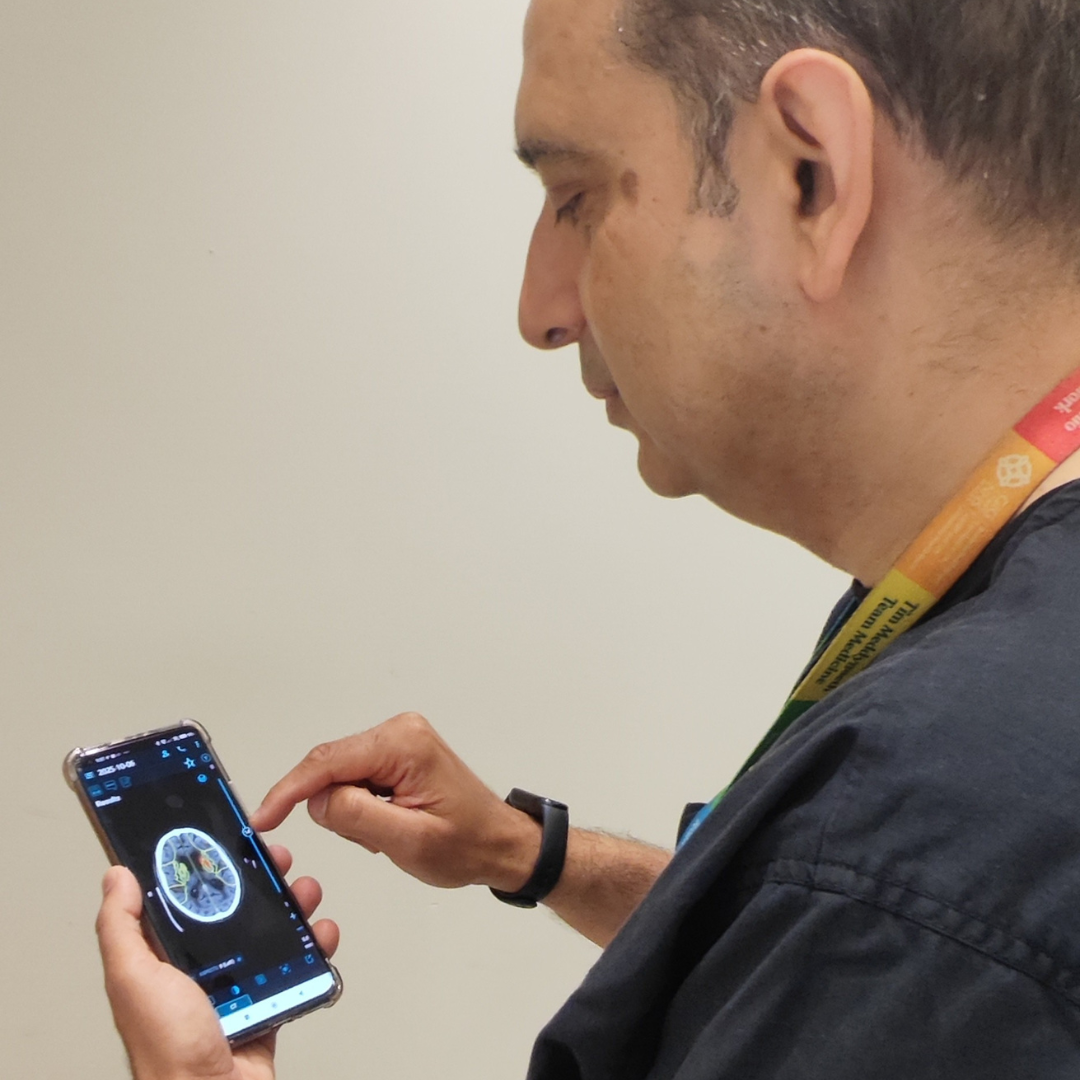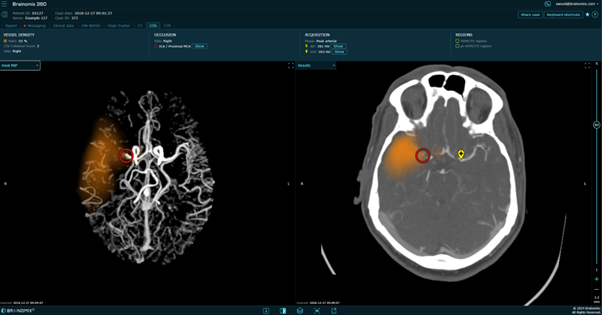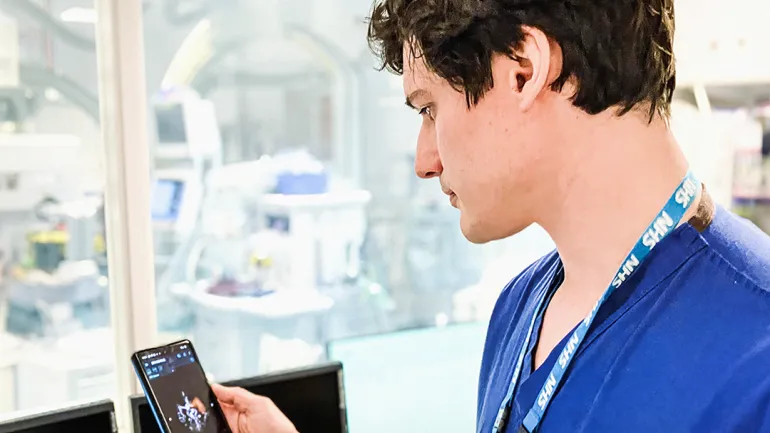Wales led the way in the UK for adopting AI at scale, when a national rollout to improve stroke care was approved. Here, we fill you in on Brainomix and how it’s supporting a nationwide shift in outcomes for stroke patients.

The challenge in stroke
There are two major challenges in the stroke pathway: speed and accuracy. After a stroke, a patient loses almost 2 million brain cells every minute. Speed of diagnosis is crucial and pivotal to the patient outcome. At the same time, some of the signs of stroke can be very subtle and depend on the skill and time a clinician has to read a brain scan.
In 2015, a radical shift happened in the treatment of strokes. Pre-2015, the first line of treatment was thrombolysis – the injection of a clot-busting drug. Then, a series of studies recommended thrombectomy – the surgical removal of a clot – as the second line of treatment for eligible patients.
Thrombectomy is a highly effective treatment – one in every 2–3 patients will have a favourable outcome (in other words, a speedy recovery and return to being able to function independently), compared to one in seven patients treated with thrombolysis. As well as the patient benefits, a successful thrombectomy saves the NHS around £45,000 over five years.
But, the ‘need for speed’ is even more pronounced. A thrombectomy is normally only suitable within around a six-hour window after symptoms begin.
Brainomix
This is where Brainomix comes in. The UK-based company was established in 2010 as a spinout from Oxford University, with the vision to transform stroke care. In 2016, it launched the world’s first AI solution for stroke, just in time to support the introduction of thrombectomy as a treatment option.
The impact of AI on stroke treatment
The Brainomix 360 stroke platform acts as a clinical decision support tool that can enhance and speed up decision making. Within minutes of a suspected stroke patient having a brain scan, the AI-powered tool can analyse the image and alert the clinical team to the results.
Where a stroke has been detected, the patient can be prioritised and the relevant teams prepared to act.

Example output from the Brainomix platform, where a large vessel occlusion (LVO) (blood clot) has been detected
Around 10% of patients are typically eligible for a thrombectomy if the diagnosis is made in time. However, until now, the treatment rates have hovered much below that figure, with UK-wide averages of 2–4%. Removing delays in the care pathway is a key factor in shifting this average.
In the largest ever real-world evaluation of AI stroke imaging (involving more than 450,000 patients across 26 sites in England), the Brainomix tool was associated with a 50% increase in the number of patients receiving thrombectomy. In fact, in the Orebro region in Sweden has even increased their thrombectomy rate to 23% of patients!
The impact in Wales
Wales is the first UK nation (and one of only three to-date globally) to adopt this technology on a national basis. In conjunction with a national delivery plan to create a network of stroke centres across Wales, every suspected stroke in Wales now benefits from an enhanced stroke AI connected pathway.
Since the rollout began in 2023, over 17,000 cases have been screened in Wales, resulting in faster diagnosis and treatment for the whole population.
In practice, the Brainomix alert system means that, in some cases, the surgical team can proactively engage with peripheral hospitals, even before the treatment pathway has been enacted.
As a result, more and more strokes are being picked up in time for effective treatment. In 2022–23, the thrombectomy rate in Wales was 1.8%. After rolling out Brainomix as a support tool, this nearly doubled in 2023–24 (to 3.1%). In Cardiff and Vale, the improvement is more pronounced and thrombectomy rates have climbed to 8–9%. Meanwhile, thrombolysis rates also climbed from 6–7%, to over 20% (with 20% being the gold standard rate for this treatment). Ultimately, the goal is for all of Wales to also reach the thrombectomy gold standard of 10%, which would indicate the vast majority of those eligible for thrombectomies are receiving one.
Adopting AI
As one of the first AI solutions to be adopted in Wales, achieving adoption nationwide came with its challenges. Some of the learnings included:
- Thinking big paid off in the end. Going for a national rollout was challenging in the short term, but once achieved, means equity across all of Wales. Combined with a new thrombectomy centre in Cardiff, this is a huge leap forward for stroke patients in Wales.
- Project management was critical. One central project manager was key to co-ordinating all the health boards, across the various stakeholders including IT, governance and clinical leads.
- Achieving buy-in from the ground-up is essential. AI is a relatively new technology and there is still some scepticism. But we’ve found that when the data, evidence and real-life case studies show a tool brings value to the system, clinicians are quick to get on board.
- Be an honest broker. No tool is foolproof and it’s important to be clear how false results can come about (and include this in training). We’re clear that Brainomix is always intended as a decision support tool for clinicians, who use much more than imagery to inform their decision making.
What’s next for Brainomix and stroke care in Wales?
Brainomix’s stroke tool is now being used across 35 countries and 400 hospitals, with more than 2.2 million patients treated with the tech to-date. Stroke care is deeply embedded in the origins of the company, but a new product for lung disease has also just been launched.
When it comes to stroke, the next leap will be expanding from the large, central vessels in the brain, to being able to address the small, more distal vessels. Brainomix is currently trialling new technology to achieve this, so, over the next few years, we expect to be able to detect clots in more areas and, ultimately, achieve full coverage of the brain.
In Wales, digitising the entire stroke pathway is also a goal. A tool for pre-hospital video triage is currently being trialled across five health boards, through a partnership with another UK-based company, Visionable. Wales is the only place to be using both Visionable and Brainomix’s tools to attempt to track and improve a stroke patient’s experience right back to the ambulance journey, yet again showing the ambition for advancement in Wales.
Learn more about the innovative solutions delivered by Brainomix here.
Blog authors:
Riaz Rahman, Sales Director, EMEA, Brainomix and Dr Shakeel Ahmad, National Clinical Lead for Stroke


